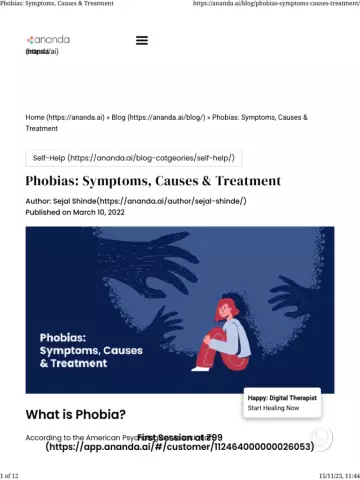- Author Rachel Wainwright [email protected].
- Public 2023-12-15 07:39.
- Last modified 2025-11-02 20:14.
Neurasthenia
The content of the article:
- Causes and risk factors
-
Forms of the disease
- Hypersthenic neurasthenia
- Hyposthenic neurasthenia
- Disease stages
- Symptoms of neurasthenia
- Features of the course of neurasthenia in women
- Diagnostics
-
Treatment of neurasthenia
- Lifestyle modification
- Drug therapy
- Psychotherapy
- Possible complications and consequences
- Forecast
- Prevention
- Video
Neurasthenia is a mental disorder belonging to the group of neuroses. This is an asthenic condition, which is manifested by frequent or constant headache, excessive fatigue, mood lability, sleep disorders, inability to any prolonged and consistent physical and mental effort, irritability in response to harsh sounds, bright light, strong odors. The cause of this pathological condition is overload and depletion of the nervous system.

Neurasthenia - a disease that occurs when the nervous system is exhausted
Neurasthenia can act as an independent disorder or accompany various somatic and mental illnesses, in this case it is considered as a neurasthenic syndrome.
Synonyms: neuropsychic weakness, asthenia, asthenic-neurotic syndrome, asthenic neurosis.
Causes and risk factors
Asthenic neurosis develops as a result of disruption of the functioning of the higher regulation of the nervous system. This is caused by excessive psychoemotional stress in combination with physical factors, for example, insufficient rest for a long time, monotonous exhausting work, unbalanced diet, bad habits, diseases.
Two types of neurasthenia are distinguished depending on the predominant etiological factor:
- reactive - arises in response to stress, physical or mental trauma, psycho-emotional overload;
- secondary (neurotic syndrome) - caused by another disease.
Risk factors include everything that causes mental, mental and physical exhaustion:
- insufficient night rest;
- lack of a balanced work and rest regime, irregular working hours;
- bad habits;
- poor nutrition (insufficient, unbalanced, irregular);
- social problems;
- financial distress;
- hypodynamia or, on the contrary, excessive physical activity;
- infections and other diseases (infectious diseases, metabolic disorders, hypertension, oncological pathology, injuries and their consequences, etc.);
- insufficient stay in the fresh air;
- no change of scenery for a long time.
People with increased responsibility are predisposed to neurasthenia, prone to perfectionism, carrying the burden of responsibility in relation to other people who depend on them, who feel the need to adhere to a certain social status at all costs, as well as those whose activities are associated with making important decisions in limited time conditions.
The most vulnerable in relation to neurasthenia are adolescents, students, young mothers, middle-aged people of certain professions, and the elderly.
Forms of the disease
There are two forms of neurasthenic disorder - hypersthenic and hyposthenic, sometimes they are considered as successive stages of the disease.
Hypersthenic neurasthenia
Development is based on the mechanism of strengthening the processes of brain excitation with weakening of the processes of inhibition. This is the initial stage of pathology, which is manifested by excessive excitability, increased irritability, which constantly accompany a person and are manifested in all areas of his activity.
Signs:
- increased irritability: irritability, tension, irascibility;
- emotional instability;
- anxiety;
- difficulty concentrating;
- memory impairment;
- trouble falling asleep, restless interrupted sleep, waking up early, feeling weak after sleep;
- decreased ability to work, difficulty in making a mental or physical effort;
- vegetative and somatic manifestations (tachycardia, palpitations, increased sweating, dizziness, headache).
Hyposthenic neurasthenia
It is characterized by the predominance of inhibition processes over arousal.
Signs:
- weakness, lethargy;
- apathy:
- depressed mood, tearfulness;
- emotional lability;
- increased sleepiness, daytime sleepiness, trouble falling asleep, poor sleep quality;
- fixation on ailments, hypochondriacal condition.
Disease stages
In the course of neurasthenia, three stages are distinguished:
- Increased irritability. Quite ordinary things cause strong irritation: conversation, insignificant noise, awkwardness, minor failures. For trifling reasons, the patient loses his composure and becomes enraged. Difficulty falling asleep, sleeping poorly, waking up sleepy, feeling tired throughout the day.
- An increase in symptoms. Even resting does not help the symptoms disappear or even reduce them. The patient is constantly tired, any work involves considerable effort. Attacks of powerlessness, tearfulness appear.
- A stage of severe nervous disorder characterized by complete disability. The patient is apathetic, lethargic, drowsy, depressed, does not show interest in what previously occupied him.
Symptoms of neurasthenia
Early signs of neurasthenia are similar to symptoms of overwork: constant fatigue, difficulty in performing mental or physical work, inability to concentrate on performing necessary tasks, distraction, intolerance to stress. What distinguishes neurasthenia from physiological fatigue is that the symptoms gradually progress (sometimes for more than one year), intensify over time and do not go away even after prolonged sleep. However, it is not so easy to achieve long sleep, because insomnia (insomnia) is one of the characteristic signs of a neurasthenic state. Despite fatigue, a person experiences difficulty falling asleep (the period of falling asleep can last several hours), his sleep is shallow, his dreams are disturbing, and he often wakes up too early. After sleep, vivacity and a surge of strength do not come, fatigue remains. Sometimes patients, on the other hand,experience constant drowsiness, but in this case, sleep does not bring relief.

With neurasthenia, the emotional state of patients suffers
The emotional state is disturbed, the patients are irritable, and any trifle can serve as a reason for a strong emotional outburst. Exhaustion quickly follows the release of emotions. Neurasthenia differs from ordinary emotional incontinence in that a bad mood has practically no bright intervals, there are no periods of emotional uplift, a person loses the ability to enjoy life. Other patients have a tendency to tearfulness, they often cry for the smallest reasons, and sometimes without them.
This condition worries people, they realize that it is atypical and abnormal for them, and this anxiety, developing into constant anxiety, further exacerbates the symptoms.
Mental and physical exhaustion is accompanied by physical symptoms:
- persistent compressive headache of a girdle character, so characteristic of this condition that it was called the "neurasthenic helmet";
- dizziness;
- tachycardia;
- hyperhidrosis (excessive sweating);
- drops in blood pressure;
- decreased appetite or, conversely, compulsive overeating;
- decreased libido, decreased potency in men;
- nasty.
If we are talking about a neurotic syndrome that accompanies a somatic illness, signs of physical exhaustion come to the fore, and if neurasthenia is a mental disorder, psychoemotional disorders become the main manifestations. However, in both cases there are manifestations, both mental and physical.
Features of the course of neurasthenia in women
It is widely believed in society that neurasthenia occurs in women much more often than in men. These data are not confirmed either statistically or by clinical practice. Both sexes suffer equally from asthenic neurosis, however, due to cultural characteristics, women are more inclined to show symptoms, while men are instructed to be restrained in their manifestations of emotions. A feature of the course of neurasthenia in women can be called its more pronounced nature, which helps in the timely detection and treatment of the disease. In men, neurasthenia is more often diagnosed at later stages, respectively, it is more severe, this is due to the fact that men tend to start this condition and seek medical help late.
Diagnostics
Diagnosis of neurasthenia is a difficult task, especially in the early stages, since this condition is similar both to normal fatigue and psychogenic reactions, and to the initial symptoms of most mental illnesses. Therefore, a neurologist conducts a thorough and detailed survey of the patient, studying his anamnesis, emotional state, reaction to external signals, and mnestic abilities.

If neurasthenia is suspected, it is necessary to undergo a neurological examination
With neurasthenic syndrome, an examination is necessary in order to identify the underlying disease. The examination includes the diagnosis of infectious diseases (bacteriological analysis, PCR), blood and urine tests, instrumental studies, consultations of narrow specialists may be required.
Asthenia is assessed according to SHAS - the Asthenic State Scale, which is based on the MMPI questionnaire (Minnesota Multiphasic Personality Inventory, Minnesota Multidimensional Personality Inventory). The patient is asked to complete a 30-item questionnaire (certain statements should be confirmed or refuted). The test room has special requirements: it should not be noisy, it should be well lit and comfortable. The presence of asthenia is assessed by the points scored:
| Number of points | The presence of asthenia |
| 30-50 | Absent |
| 51-71 | Weak |
| 76-100 | Moderate |
| 101-120 | Expressed |
Differential diagnosis is carried out, first of all, with depression (depression is characterized by melancholy, pessimism, low self-esteem, an increase in the state in the morning, with neurasthenia, self-esteem usually does not suffer, anxiety, irritability or apathy are characteristic, the condition intensifies in the evening). Differentiation with hypersomnia (with increased drowsiness), hypochondriacal neurosis, reactive neurosis / psychosis is also necessary.
Treatment of neurasthenia
Treatment for neurasthenia consists of lifestyle modification, medication, and psychotherapy, all three of which are equally important.
Lifestyle modification
- Compliance with the regime of work and rest.
- Adequate sleep (it is necessary to go to bed and wake up at the same time, in case of severe sleep disorders, they resort to medicinal assistance in its establishment).
- Complete nutrition - balanced, enriched with vitamins and minerals, regular, taking into account the possible underlying disease.
- Calm environment at work and at home. If your job involves regular heavy emotional or physical stress, you may need to change it.
- Regular, but moderate, recreational physical activity in the form of exercise therapy, swimming, dancing, long walks, morning jogging - the type of load is chosen by the patient in accordance with his preferences.
- Refusal from alcohol abuse and, if possible, smoking.
A change in the usual environment, for example, traveling, can be effective, but without other measures, the positive effect will be temporary, and after returning to life, the symptoms of the disorder will return.
Drug therapy
Drug therapy for neurasthenia is symptomatic. In case of increased irritability, sedatives are prescribed, drugs that help to establish normal sleep. Antidepressants and antipsychotics are used if necessary. If asthenia is secondary, the treatment of the underlying disease comes to the fore, which helps to cope with the manifestations of neurasthenic syndrome. Vitamin therapy is indicated.

With increased irritability, sedatives are used
Self-medication is highly undesirable, which is highly likely to have significant side effects and can lead to the opposite effect, i.e., increased symptoms.
Psychotherapy
The main task of psychotherapy in this case is to increase stress resistance. The patient is trained in relaxation techniques, proper timing, methods of increasing personal efficiency.
Possible complications and consequences
In severe cases of neurasthenia, it can turn into major depressive disorder with all the associated consequences.
Forecast
In the case of seeking medical help, the prognosis is good, and although treatment can be lengthy, patients generally recover completely. In the absence of treatment, the prognosis is cautious: it is possible both spontaneous recovery under the influence of certain external factors (for example, a change in lifestyle due to relocation, a change in job, or a change in the composition of the family), and aggravation of a mental disorder with asocialization and depression.
Prevention
The measures for the prevention of neurasthenia include all those indicated in the chapter "Lifestyle modification".
Video
We offer for viewing a video on the topic of the article.

Anna Kozlova Medical journalist About the author
Education: Rostov State Medical University, specialty "General Medicine".
The information is generalized and provided for informational purposes only. At the first sign of illness, see your doctor. Self-medication is hazardous to health!






